In your search for the perfect yellow gold ring you’ve probably come across 10k, 14k and 18k gold options. But what exactly do these numbers mean and which one should you choose?
To help you decide, let’s start with a visual comparison:

The first image compares simple yellow gold rings in 10K, 14K and 18K, giving you a quick sense of their surface tone differences. Just below that, you’ll see all three gold purities again: this time in the form of identical Cuban link chains, which are one of the few jewelry styles commonly crafted in all three karat types using the exact same design and finish.
These side-by-side visuals make it easy to see how the color gradually deepens as the gold content increases. While chains offer a clear view thanks to their broad polished surfaces, the same color differences apply to rings, earrings, bracelets and other yellow gold jewelry.
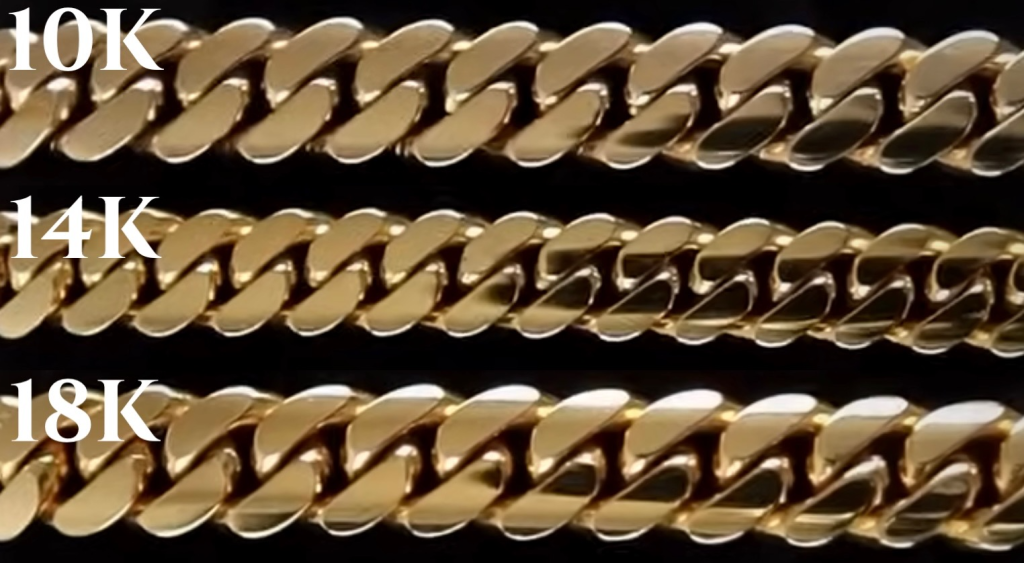
The “k” stands for karat, a unit that measures the purity of gold. This is different from carat (with a “c”), which refers to the weight of diamonds.
To keep it simple:
- Karat (K) = how much gold is in the metal
- Carat (ct) = how much the diamond weighs
For example, a 1-carat diamond weighs 0.2 grams, while 18-karat gold means the metal is 75% pure gold.
10k vs 14k vs 18k Gold: Quick Comparison Chart
If you’re in a hurry or just want a straightforward summary, this chart breaks down the main differences between 10k, 14k and 18k yellow gold. It shows how they compare in terms of purity, durability, color, price and who each one is best suited for:
| Gold Type | Gold Content | Durability | Color | Price | Popularity (U.S.) | Best For |
|---|---|---|---|---|---|---|
| 10K Gold | 41.7% gold 58.3% alloy |
Very high (most scratch-resistant) |
Pale yellow | 💲 (lowest) |
~10-15% | Budget buyers Durable everyday wear |
| 14K Gold | 58.5% gold 41.5% alloy |
High (balanced durability) |
Warm yellow | 💲💲 (moderate) |
~75-85% | Most people Engagement & wedding rings |
| 18K Gold | 75% gold 25% alloy |
Moderate (softer, more care needed) |
Rich yellow | 💲💲💲 (highest) |
~5-10% | Luxury shoppers Low-wear pieces |
You might wonder: why are gold jewelry options almost always limited to just 10K, 14K and 18K? What happened to 12K or 16K?
The answer comes down to a balance of industry standards, durability, cost-efficiency and consumer recognition. Over time, the jewelry industry standardized around these three options because each one offers a clear use case:
- 10K gold is the most affordable and durable option
- 14K gold strikes the best balance between gold content, strength and price
- 18K gold offers a more luxurious appearance with high purity, but still wearable
Jewelry made with odd karat values like 12K or 16K exists but is extremely rare. These purities don’t offer any significant advantage and are not standardized globally, making resale, appraisal and manufacturing more complex.
14K vs 18K Gold: Is the Upgrade Worth It?
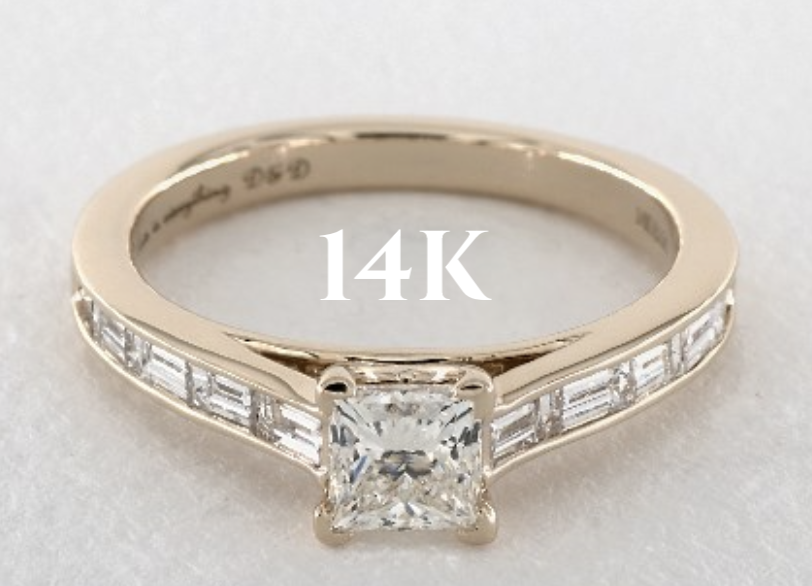
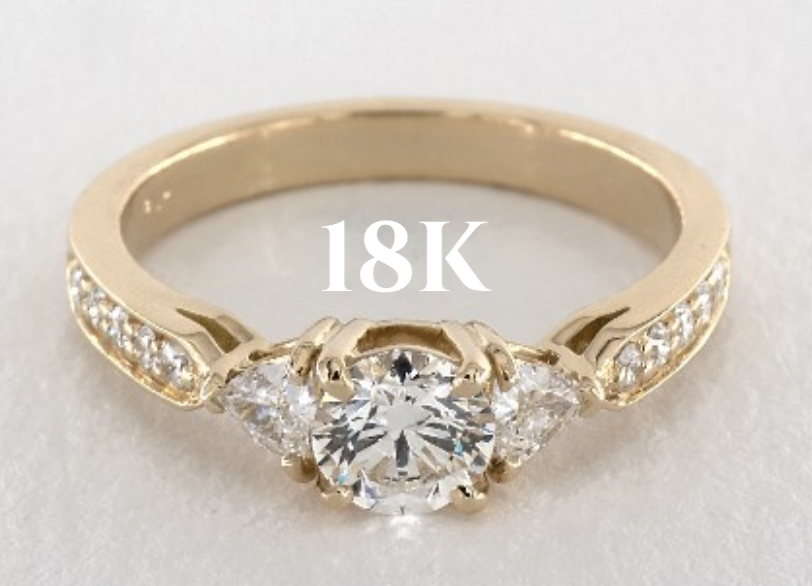
Once you’ve settled on yellow gold for your jewelry, the next big question is whether to go with 14K or 18K. Both are considered premium gold options but they offer different strengths.
Here’s how they compare in the real world:
| Feature | 14K Gold | 18K Gold |
|---|---|---|
| Gold Content | 58.5% gold 41.5% alloy |
75% gold 25% alloy |
| Color | Warm yellow | Richer, deeper yellow |
| Durability | More scratch-resistant Great for daily wear |
Softer, needs more care Better for occasional wear |
| 4mm Wedding Ring Price Example | $500 – 14K Yellow Gold Low Dome Wedding Ring | $730 – 18K Yellow Gold Low Dome Wedding Ring |
| Solitaire Engagement Ring Price Example | $640 – 14K Yellow Gold Solitaire Engagement Ring | $910 – 18K Yellow Gold Solitaire Engagement Ring |
| Tarnish Resistance | Very good | Excellent |
| Visual Difference | Subtle difference Not easily noticeable |
Slightly richer tone Often only noticeable side-by-side |
| Prestige Factor | Industry standard | Luxury appeal |
As of May 2025, a simple 4mm wedding ring in 14K yellow gold costs $500 on James Allen, while the same ring in 18K yellow gold is priced at $740. That’s a 48% increase purely due to the gold content.
On Blue Nile, a classic solitaire engagement ring in 14K yellow gold is currently priced at $640, whereas the 18K version costs $910, a 42% jump for the same design and setting style.
In general, you can expect a 30% to 50% price increase when upgrading from 14K to 18K gold, depending on the weight of the piece and the retailer’s pricing structure.
14K vs 18K Gold Direct Comparison
Whether you should go for 14K or 18K gold depends on your priorities:
- Choose 14K gold if you want a durable, beautiful ring that looks luxurious but can handle daily wear. It’s the most practical choice and still feels special.
- Choose 18K gold if you love knowing your jewelry contains more pure gold, or if you’re gifting a luxury piece that won’t be worn every day.
In real life, the differences between 14K and 18K gold rings are quite subtle. The most noticeable distinction is in color. 18K gold has a slightly richer, deeper yellow tone due to its higher gold content, but this difference is usually only visible when both rings are placed side by side. On its own, 14K gold still looks beautifully warm and unmistakably golden. Most people would not be able to tell which is which without a direct comparison.
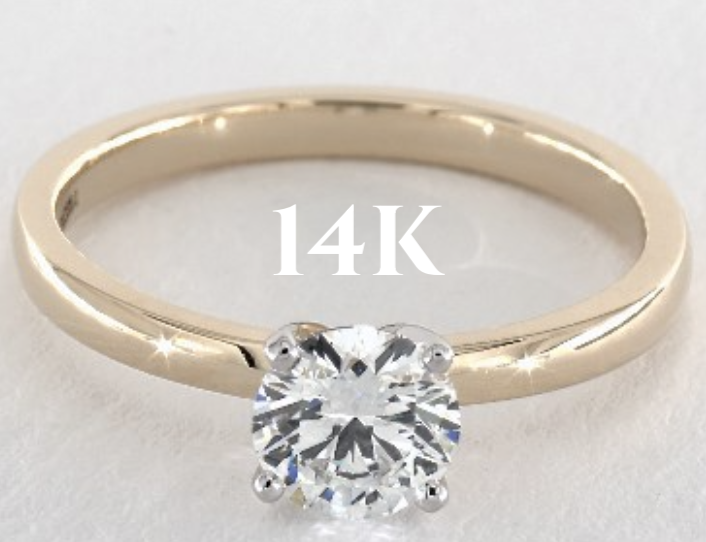
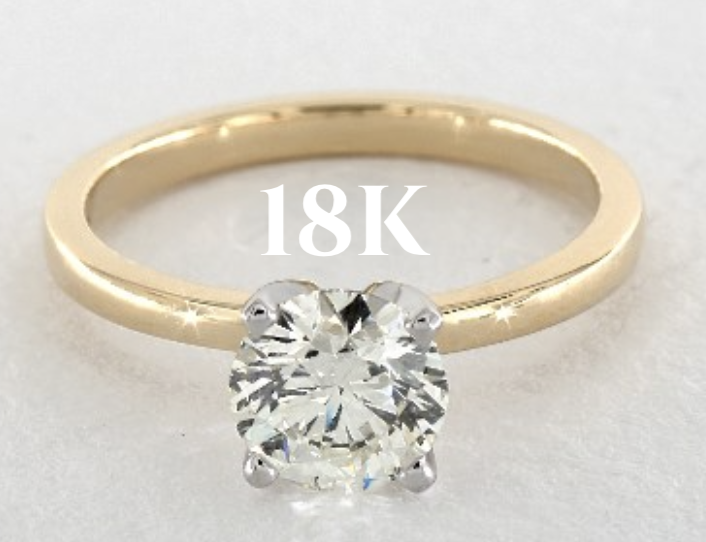
The two images above show the exact same solitaire ring setting from James Allen, photographed under the same lighting conditions. The only difference is the gold purity: the first is made in 14K yellow gold and the second in 18K yellow gold. If you look closely, you’ll notice that the 14K gold has a soft, muted yellow tone: warm and elegant, but slightly more understated. In contrast, the 18K gold appears noticeably richer and more saturated with a deeper golden hue that reflects its higher gold content. The distinction is subtle but clear when viewed side by side like this, especially around the rounded shoulders and inner edge of the band where light hits most directly.
The same gold tone difference can also be seen in pavé and halo settings. In the two images below you’re looking at the exact same pavé hlo ring setting from James Allen, again photographed under identical lighting. While the center stones differ in shape (oval vs. pear), the setting itself including the pavé band and halo is the same. The 14K gold ring shows a slightly lighter, peachier tone, which complements the bright white sparkle of the small diamonds. The 18K gold version, by contrast, has a deeper, more golden appearance, adding a touch of warmth and richness that subtly shifts the overall look. This side-by-side view is especially helpful for seeing how gold purity interacts with pavé stones and how a warmer gold tone can slightly soften the brilliance of accent diamonds, while a cooler tone enhances contrast:
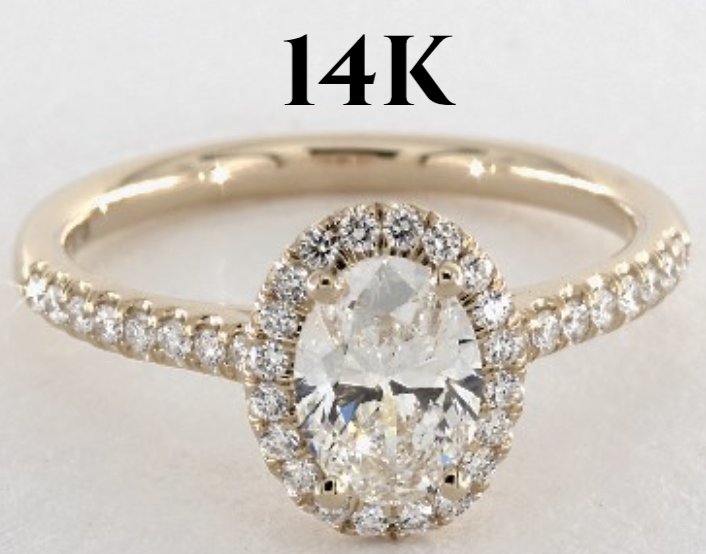
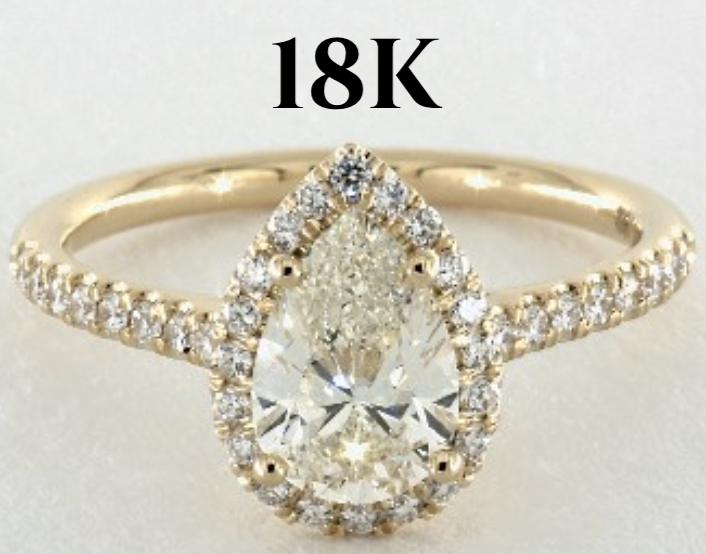
If you’re curious about the pros and cons of different setting types like solitaires, halos, pavé or bezel designs, check out my complete ring settings guide. It breaks down each style with visual examples and real buying advice.
It’s also worth noting that not all 14K or 18K gold looks exactly the same. While the gold purity is fixed by definition, the exact blend of alloy metals (like copper, silver, or zinc) can vary slightly between manufacturers and even between batches from the same manufacturer. This means that two 14K gold rings or two 18K gold rings might show subtle differences in color, especially under diffuse natural light or warm indoor lighting, which tend to highlight subtle color variations in gold alloys more clearly. These variations are completely normal and often more noticeable when pieces are compared side by side.
To help you choose the right gold type based on your specific jewelry style or setting, here’s a quick breakdown of what works best and why:
| Jewelry Style or Setting | Best Gold Type(s) | Why It Works Best |
|---|---|---|
| Solitaire Ring Settings | 14K (practical) 18K (luxury) |
14K is the most popular and durable for daily wear, 18K has a richer color that stands out beautifully on plain polished bands. |
| Pavé Ring Settings | 14K Gold | Provides stronger contrast with small diamonds, making pavé sparkle more visibly. |
| Vintage or Ornate Ring Settings | 18K Gold | Softer metal allows finer detailing, the richer yellow tone complements vintage styles well. |
| Plain Wedding Bands | 14K (practical) 18K (luxury) |
14K is more durable and widely used for everyday bands, 18K offers a richer color that stands out on polished surfaces. |
| Engagement Rings (General) | 14K Gold | Durable, affordable and widely used for everyday wear, it’s the industry standard in the U.S. |
| Gold Chains (Everyday) | 10K Gold | Highly durable and cost-effective for thicker styles like rope or curb chains. |
| Delicate Chains | 14K Gold | Offers a good balance of color, strength and value for finer, lightweight chains. |
| Earrings (Studs, Hoops) | 18K Gold | Less likely to irritate sensitive, pierced skin. The warmer tone is visible even on small pieces. |
| Bracelets & Bangles | 14K Gold | More resistant to dents and bending from wrist impact, better suited for daily wear. |
How 14K and 18K Gold Age Over Time
The image below shows the exact same 18K yellow gold solitaire ring from Blue Nile, purchased in 2004, simply photographed from two different angles under slightly different lighting conditions. These close-up views offer a valuable look at how high-karat gold can age after two decades of wear.
In the left image taken from a top-down angle you’ll notice matte areas with darkened patches, especially near the rounded parts of the band. These are classic signs of oxidation and patina, where alloy metals in the gold (like copper or silver) have slightly reacted over time. The ring’s matte finish makes this more visible, especially under soft or diffused lighting where shadows deepen.

In contrast, the right image shows the ring from the front, where the light is more direct and reflective. Here, the gold looks noticeably brighter and shinier but now you can clearly see fine scratches along the polished surface. This is a great example of how light and perspective can dramatically change the appearance of wear, even on the same ring. Marks that appear dark from one angle may vanish entirely from another.
If this ring had been made from 14K yellow gold instead of 18K, you would likely see:
- Fewer scratches, because 14K gold is harder and better resists abrasion.
- But more visible tarnish, since 14K has a higher percentage of reactive alloys (41.5% vs. 25%).
This means that 14K rings can sometimes take on a dull or “foggy” look over time if not cleaned periodically, especially on the inner band or around less-polished areas.
Wondering how yellow gold stacks up against white gold, rose gold, platinum or even alternative metals like tungsten? My complete ring metal comparison guide breaks it all down with pros, cons and care tips included.
How to Care for Aged Gold
For either 14K or 18K gold the best way to maintain long-term beauty is occasional cleaning and polishing:
- Use a gentle gold-safe cleaner or warm water with mild dish soap
- Avoid abrasive cloths or harsh polishing compounds unless done professionally
- Consider re-polishing plain bands every few years to restore their shine
For daily-wear pieces like engagement rings or wedding bands 14K gold will usually need less frequent polishing, but a bit more attention to cleaning (especially if exposed to sweat, hand lotion or chlorinated water).
For more delicate or luxury pieces made of 18K gold such as bracelets, earrings,or pendants a little more caution goes a long way. Store them individually, avoid stacking and consider removing them before manual work to minimize friction and pressure that leads to soft metal warping, denting or scratches.
10K vs 14K Gold: Where 10K makes more Sense
When it comes to gold jewelry 10K gold is often overlooked, but that doesn’t mean it lacks value. In fact, 10K gold is the most durable option of the three major karat types, thanks to its high percentage of alloy metals (58.3% alloy, 41.7% gold). This makes it especially well-suited for daily-wear items that take a lot of abuse like gold chains, men’s wedding bands or utility-style rings worn in hands-on professions.
It’s also by far the most affordable, offering a real gold option for people on a tighter budget. While some buyers assume that 10K gold isn’t “real,” that’s not true. It’s still legally classified as gold in the U.S. and many other countries. However, that durability comes at a visual cost: 10K gold has a noticeably paler, less vibrant yellow tone than 14K or 18K gold. It’s not always obvious in photos, but when placed side by side with richer gold alloys the difference becomes clear.
Below you see two matte finish yellow gold rings side by side. On the left is a 10K gold ring and on the right is its 14K counterpart. Both are crafted in a similar minimalist style, making it easy to spot the difference in tone. The 10K ring appears slightly paler and flatter in color, while the 14K gold shows a richer and warmer yellow hue, even without any reflective polish.
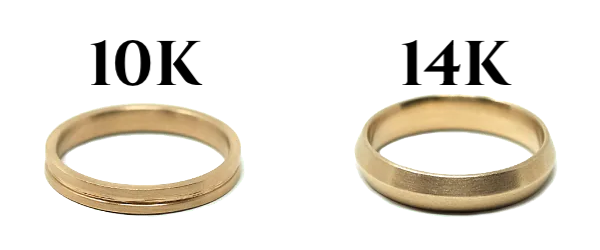
And once again below the same karat comparison is shown, but this time with a high polish (mirror) finish. The difference becomes even more pronounced here. The 10K gold ring on the left still maintains a lighter, more muted yellow, whereas the 14K ring on the right has a deeper golden glow that catches and reflects light more vividly. This side-by-side shot clearly highlights the visual upgrade 14K gold offers in both luster and color saturation.
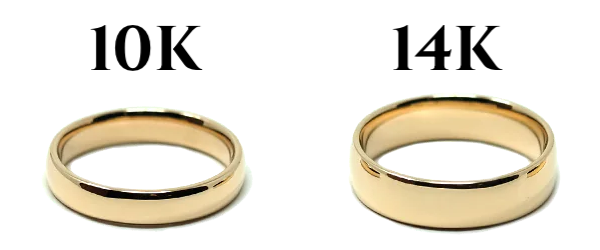
For rings 10K gold is not typically offered by premium jewelers like James Allen, Blue Nile or Brilliant Earth and that’s mostly because the appearance doesn’t match the expectations of buyers investing in higher-end diamonds. Still, there’s a niche where 10K gold makes a lot of sense.
10K gold can be a smart, low-risk choice for rings like promise rings, budget-conscious engagement rings or temporary settings used to hold a center stone during a proposal before upgrading to a permanent design later on. Some buyers also choose 10K gold for heirloom-style pieces that will be worn occasionally but need to withstand the test of time.
Just keep in mind: 10K’s high alloy content means it may cause irritation for those with metal sensitivities, especially if the alloy includes nickel. In contrast, 14K gold strikes a better balance: more gold content, warmer color and enough hardness to be suitable for everyday wear, which is why it remains the industry standard for both engagement rings and fashion jewelry.
Our Key Takeaway
Choosing between 10K, 14K and 18K yellow gold comes down to your priorities: durability, color richness, budget and long-term wear. 10K gold is the most durable and affordable, ideal for everyday chains, occasional rings or rough-wear scenarios, though it has a paler color and is rarely used in high-end engagement rings.
14K gold remains the industry standard, offering a perfect balance of strength, warm tone and affordability. It’s the most popular choice for engagement rings, wedding bands, and daily-wear jewelry.
18K gold, on the other hand, offers a deeper, more luxurious yellow color with a softer feel. It’s best for those who value richness in tone and don’t mind taking a little extra care to maintain it.
No matter which gold type you choose, knowing how it holds up over time and how it interacts with different setting styles can help you make a smarter, more confident decision. If you’re looking for a wide selection of 14K and 18K yellow gold jewelry, including rings, earrings, necklaces and more, I recommend browsing trusted online retailers like James Allen or Blue Nile. Their collections make it easy to compare metal types side by side and see how each karat looks in real settings.